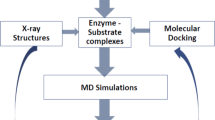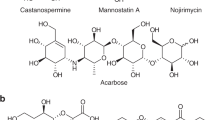Abstract
The enzyme (β-Hex) has a specific role in the degradation of a particular type of glycolipid, the GM2 ganglioside. This specificity is also manifested by its unusual mechanism of substrate-assisted catalysis, which is considered to be an alternative pathway for the breakage of glycosidic bonds. We have studied its catalytic mechanism using a small model of the enzyme: substrate Michaelis complex with DFT and MP2/MP3 methods. The results reflect the intrinsic chemical reactivity of the active site, decoupled from the long-range enzyme electrostatic field. The mechanism supports, and adds further atomic detail, on the earlier mechanistic suggestions based on experimental data. Moreover, we also have compared the geometry and full potential energy surface obtained with nine different exchange–correlation functionals. It was surprising that the B3LYP activation energies were lower than the ones from some of the hybrid meta functionals (known by their excellent performance on kinetics) by as much as 10 kcal/mol and lower than the MP2 energies by more than 12 kcal/mol. It is known that B3LYP underestimates barriers but underestimations of this extent are unusual and surprising. The effect of the theoretical method on the geometry, usually supposed to be less significant, had in some cases a relevant influence in the mechanism. Therefore, a more thoughtful choice should be made when choosing a methodology for geometry optimization.







Similar content being viewed by others
References
Wolfenden R, Lu XD, Young G (1998) Spontaneous hydrolysis of glycosides. J Am Chem Soc 120(27):6814–6815
Zechel DL, Withers SG (2000) Glycosidase mechanisms: anatomy of a finely tuned catalyst. Acc Chem Res 33(1):11–18
Mark BL et al (2001) Crystallographic evidence for substrate-assisted catalysis in a bacterial beta-hexosaminidase. J Biol Chem 276(13):10330–10337
Lemieux MJ et al (2006) Crystallographic structure of human beta-hexosaminidase A: interpretation of Tay-Sachs mutations and loss of G(M2) ganglioside hydrolysis. J Mol Biol 359(4):913–929
Proia RL, Soravia E (1987) Organization of the gene encoding the human beta-hexosaminidase alpha-chain. J Biol Chem 262(12):5677–5681
Korneluk RG et al (1986) Isolation of CDNA clones coding for the alpha-subunit of human beta-hexosaminidase—extensive homology between the alpha-subunits and beta-subunits and studies on Tay-Sachs disease. J Biol Chem 261(18):8407–8413
Sandhoff K, Wassle W (1971) Purification and characterisation of 2 forms of human N-acetyl-beta-D-hexosaminidase. Hoppe-Seylers Zeitschrift Fur Physiologische Chemie 352(8):1113–1119
Leopoldini M et al (2007) The role of quantum chemistry in the elucidation of the elementary mechanisms of catalytic processes: from atoms, to surfaces, to enzymes. Theor Chem Acc 117(5–6):765–779
Himo F (2006) Quantum chemical modeling of enzyme active sites and reaction mechanisms. Theor Chem Acc 116(1–3):232–240
Sousa SF, Fernandes PA, Ramos MJ (2007) General performance of density functionals. J Phys Chem A 111(42):10439–10452
Schwabe T, Grimme S (2007) Double-hybrid density functionals with long-range dispersion corrections: higher accuracy and extended applicability. Phys Chem Chem Phys 9(26):3397–3406
Bras NF, Ramos MJ, Fernandes PA (2010) DFT studies on the beta-glycosidase catalytic mechanism: the deglycosylation step. J Mol Struct-Theochem 946(1–3):125–133
Frisch MJ, Trucks GW, Schlegel HB, Scuseria GE et al (2004) Gaussian 03, Revision C. 02. Gaussian, Wallingford CT
Frisch MJ, Trucks GW, Schlegel HB, Scuseria GE et al (2009) Gaussian 09, Revision A. 02. Gaussian, Wallingford CT
Zhao Y, Truhlar DG (2008) Density functionals with broad applicability in chemistry. Acc Chem Res 41(2):157–167
Author information
Authors and Affiliations
Corresponding author
Electronic supplementary material
Below is the link to the electronic supplementary material.
Rights and permissions
About this article
Cite this article
Passos, Ó., Fernandes, P.A. & Ramos, M.J. Theoretical insights into the catalytic mechanism of β-hexosaminidase. Theor Chem Acc 129, 119–129 (2011). https://doi.org/10.1007/s00214-011-0904-1
Received:
Accepted:
Published:
Issue Date:
DOI: https://doi.org/10.1007/s00214-011-0904-1




